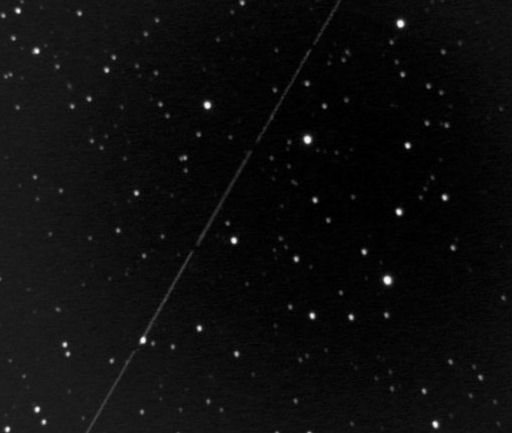QUIET WEEKEND: With the return of formerly-explosive sunspot AR1429 proving anticlimactic, solar activity is low. No strong flares are likely this weekend.
APRIL 1st ASTEROID FLYBY: Newly discovered near-Earth asteroid 2012 EG5 is flying past Earth today about halfway between Earth and the Moon. There's no danger of a collision. At closest approach on April 1st, the Dreamliner-sized space rock will be about 230,000 km from Earth. This morning in Brisbane, Australia, amateur astronomer Dennis Simmons photographed the incoming asteroid:
"On the eve of Earth Hour, whilst most of Australia was asleep, I was alone in my back garden, searching for the ghostly trail of 2012 EG5," says Simmons. "Alone but not lonely, my Celestron C9.25 and Tak EM200 mount were purring along, tracking 2012 EG5 as it flitted through the camera field only a few hours before its closest encounter. As the clock ticked over into 1st April, the estimated magnitude was approx 14.4 as it fast approached the Earth. This is to be no April’s Fool hoax – it’s for real!"
SPRITE SEASON BEGINS: The first sprites of summer are starting to appear in the skies of North America. The strange thing is, summer is almost three months away. "Sprite season is beginning early this year," says Thomas Ashcraft, who photographed these specimens on March 30th from his observatory in New Mexico:
"At precisely two minutes and twenty-six seconds after midnight March 30, 2012 there was an incredibly powerful bolt of lightning in the vicinity of Woodward, Oklahoma that spawned these red sprites," says Ashcraft. "I could see them from two states away!" He also recorded VLF and shortwave radio emissions from the cluster, which you can hear as the soundtrack to this video.
Sprites are electrical discharges that come out of the top of thunderclouds, opposite ordinary lightning bolts which plunge toward Earth. Sprites can tower as high as 90 km above ground. That makes them a form of space weather as they overlap the zone of auroras, meteors, and noctilucent clouds.
Because they are associated with lightning, sprites are most often seen in summer months, "but in the past few days sprites have been reported in Texas (particularly near the Mexican border) as well as here in New Mexico," notes Ashcraft.
So if there's lightning where you live, be alert for sprites.

![]()
Solar wind
speed: 331.7 km/sec
density: 0.3 protons/cm3
explanation | more data
Updated: Today at 1543 UT
![]()
X-ray Solar Flares
6-hr max: B3 1451 UT Apr01
24-hr: B3 1451 UT Apr01
explanation | more data
Updated: Today at: 1500 UT
![]()
![]()
![]()
Daily Sun: 01 Apr 12
![]()
![]()
Returning sunspot AR1429 is just a shadow of its former self, having decayed substantially during its two week trip around the backside of the sun. Credit: SDO/HMI
![]()
![]()
![]()
Sunspot number: 96
What is the sunspot number?
Updated 31 Mar 2012
Spotless Days
Current Stretch: 0 days
2012 total: 0 days (0%)
2011 total: 2 days (<1%)
2010 total: 51 days (14%)
2009 total: 260 days (71%)
Since 2004: 821 days
Typical Solar Min: 486 days
Updated 31 Mar 2012
The Radio Sun
10.7 cm flux: 110 sfu
explanation | more data
Updated 31 Mar 2012
![]()
![]()
![]()
Current Auroral Oval:
![]()
Switch to: Europe, USA, New Zealand, Antarctica
Credit: NOAA/POES
![]()
![]()
![]()
Planetary K-index
Now: Kp= 2 quiet
24-hr max: Kp= 2 quiet
explanation | more data
![]()
Interplanetary Mag. Field
Btotal: 6.4 nT
Bz: 5.9 nT south
explanation | more data
Updated: Today at 1547 UT
![]()
![]()
![]()
Coronal Holes: 01 Apr 12
![]()
![]()
There are no large coronal holes on the Earthside of the sun. Credit: SDO/AIA.





